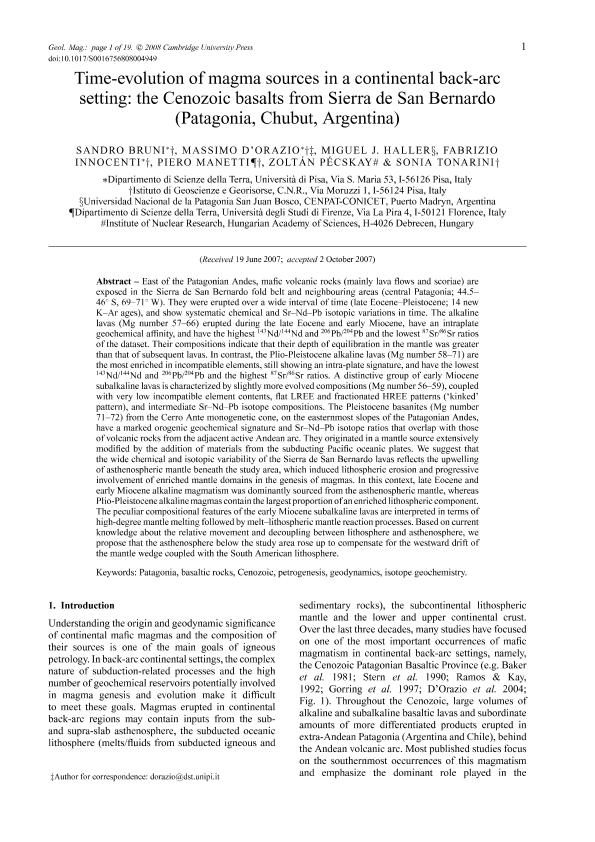Artículo
Time-evolution of magma sources in a continental back-arc setting: The Cenozoic basalts from Sierra de San Bernardo (Patagonia, Chubut, Argentina)
Bruni, Sandro; D'Orazio, Massimo; Haller, Miguel Jorge F. ; Innocenti, Fabrizio; Manetti, Piero; Pécskay, Zoltán; Tonarini, Sonia
; Innocenti, Fabrizio; Manetti, Piero; Pécskay, Zoltán; Tonarini, Sonia
 ; Innocenti, Fabrizio; Manetti, Piero; Pécskay, Zoltán; Tonarini, Sonia
; Innocenti, Fabrizio; Manetti, Piero; Pécskay, Zoltán; Tonarini, Sonia
Fecha de publicación:
12/2008
Editorial:
Cambridge University Press
Revista:
Geological Magazine
ISSN:
0016-7568
Idioma:
Inglés
Tipo de recurso:
Artículo publicado
Clasificación temática:
Resumen
East of the Patagonian Andes, mafic volcanic rocks (mainly lava flows and scoriae) are exposed in the Sierra de San Bernardo fold belt and neighbouring areas (central Patagonia; 44.5-46° S, 69-71° W). They were erupted over a wide interval of time (late Eocene-Pleistocene; 14 new K-Ar ages), and show systematic chemical and Sr-Nd-Pb isotopic variations in time. The alkaline lavas (Mg number 57-66) erupted during the late Eocene and early Miocene, have an intraplate geochemical affinity, and have the highest 143Nd/144Nd and 206Pb/204Pb and the lowest 87Sr/ 86Sr ratios of the dataset. Their compositions indicate that their depth of equilibration in the mantle was greater than that of subsequent lavas. In contrast, the Plio-Pleistocene alkaline lavas (Mg number 58-71) are the most enriched in incompatible elements, still showing an intra-plate signature, and have the lowest 143Nd/ 144Nd and 206Pb/204Pb and the highest 87Sr/86Sr ratios. A distinctive group of early Miocene subalkaline lavas is characterized by slightly more evolved compositions (Mg number 56-59), coupled with very low incompatible element contents, flat LREE and fractionated HREE patterns ('kinked' pattern), and intermediate Sr-Nd-Pb isotope compositions. The Pleistocene basanites (Mg number 71-72) from the Cerro Ante monogenetic cone, on the easternmost slopes of the Patagonian Andes, have a marked orogenic geochemical signature and Sr-Nd-Pb isotope ratios that overlap with those of volcanic rocks from the adjacent active Andean arc. They originated in a mantle source extensively modified by the addition of materials from the subducting Pacific oceanic plates. We suggest that the wide chemical and isotopic variability of the Sierra de San Bernardo lavas reflects the upwelling of asthenospheric mantle beneath the study area, which induced lithospheric erosion and progressive involvement of enriched mantle domains in the genesis of magmas. In this context, late Eocene and early Miocene alkaline magmatism was dominantly sourced from the asthenospheric mantle, whereas Plio-Pleistocene alkaline magmas contain the largest proportion of an enriched lithospheric component. The peculiar compositional features of the early Miocene subalkaline lavas are interpreted in terms of high-degree mantle melting followed by melt-lithospheric mantle reaction processes. Based on current knowledge about the relative movement and decoupling between lithosphere and asthenosphere, we propose that the asthenosphere below the study area rose up to compensate for the westward drift of the mantle wedge coupled with the South American lithosphere.
Palabras clave:
BASALTIC ROCKS
,
CENOZOIC
,
GEODYNAMICS
,
ISOTOPE GEOCHEMISTRY
,
PATAGONIA
,
PETROGENESIS
Archivos asociados
Licencia
Identificadores
Colecciones
Articulos(CCT-CENPAT)
Articulos de CTRO.CIENTIFICO TECNOL.CONICET - CENPAT
Articulos de CTRO.CIENTIFICO TECNOL.CONICET - CENPAT
Citación
Bruni, Sandro; D'Orazio, Massimo; Haller, Miguel Jorge F.; Innocenti, Fabrizio; Manetti, Piero; et al.; Time-evolution of magma sources in a continental back-arc setting: The Cenozoic basalts from Sierra de San Bernardo (Patagonia, Chubut, Argentina); Cambridge University Press; Geological Magazine; 145; 5; 12-2008; 714-732
Compartir
Altmétricas



